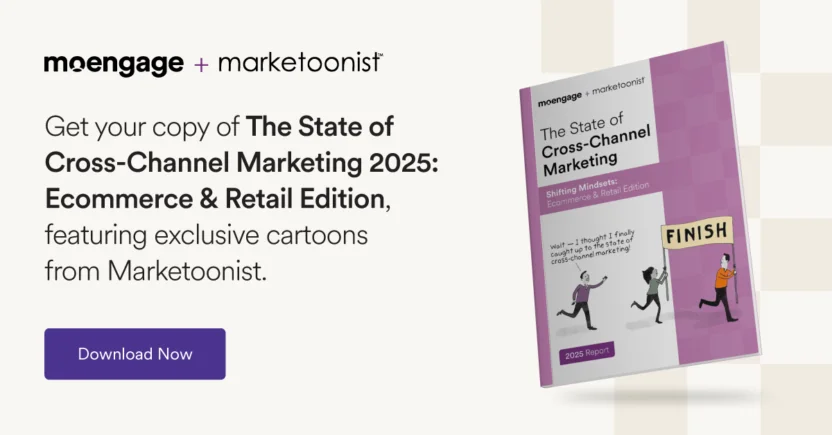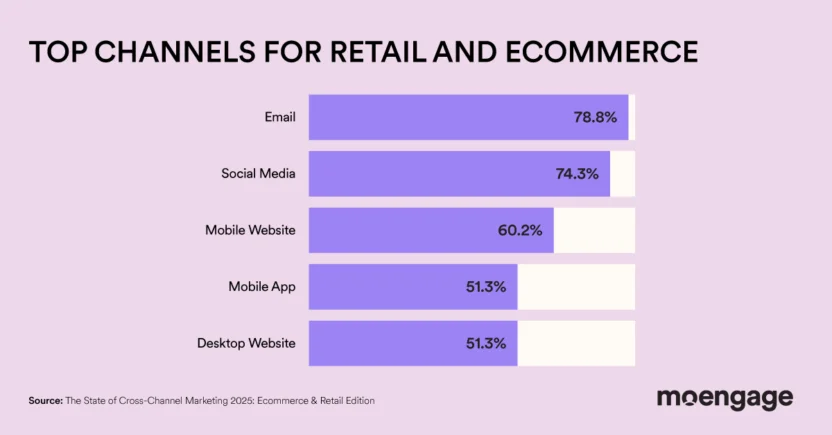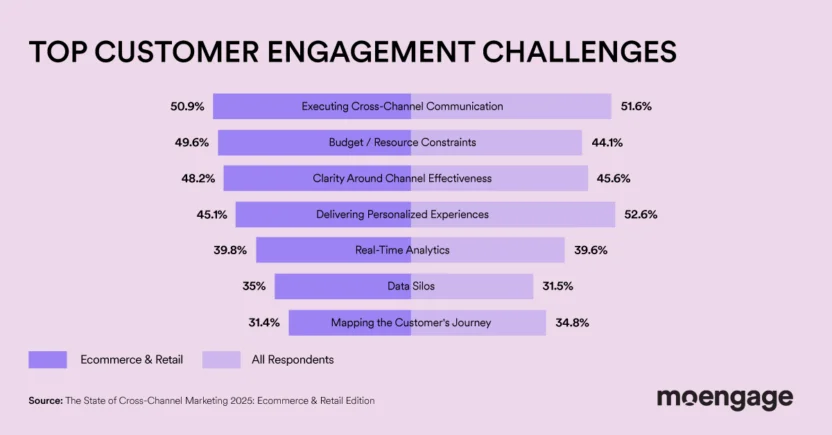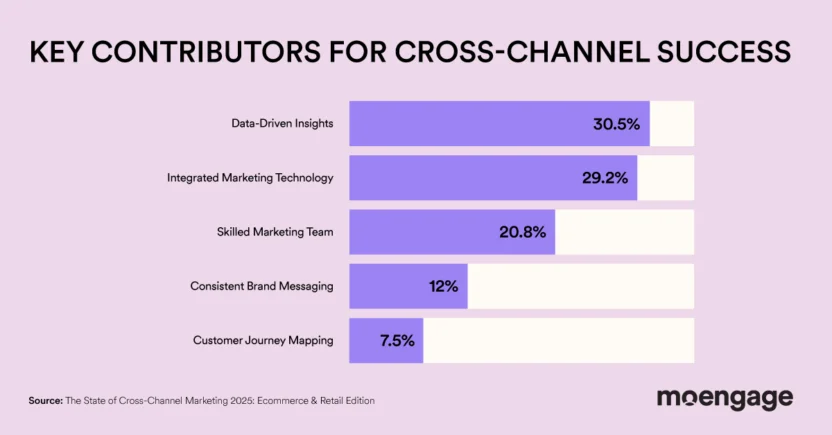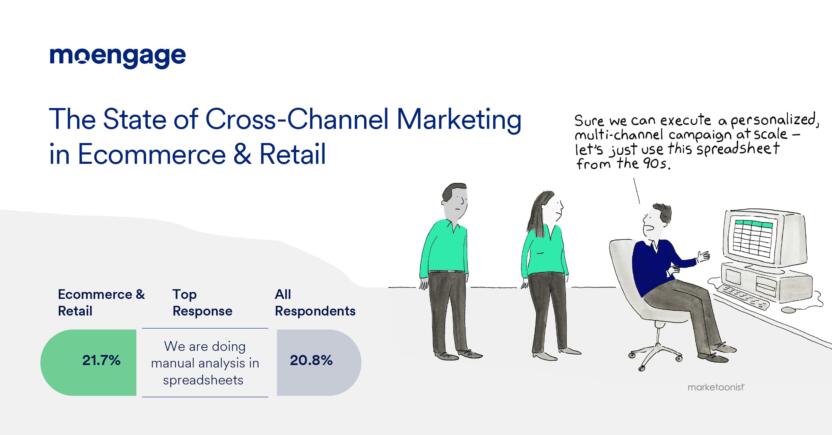The State of Cross-Channel Marketing in Ecommerce & Retail: 2025
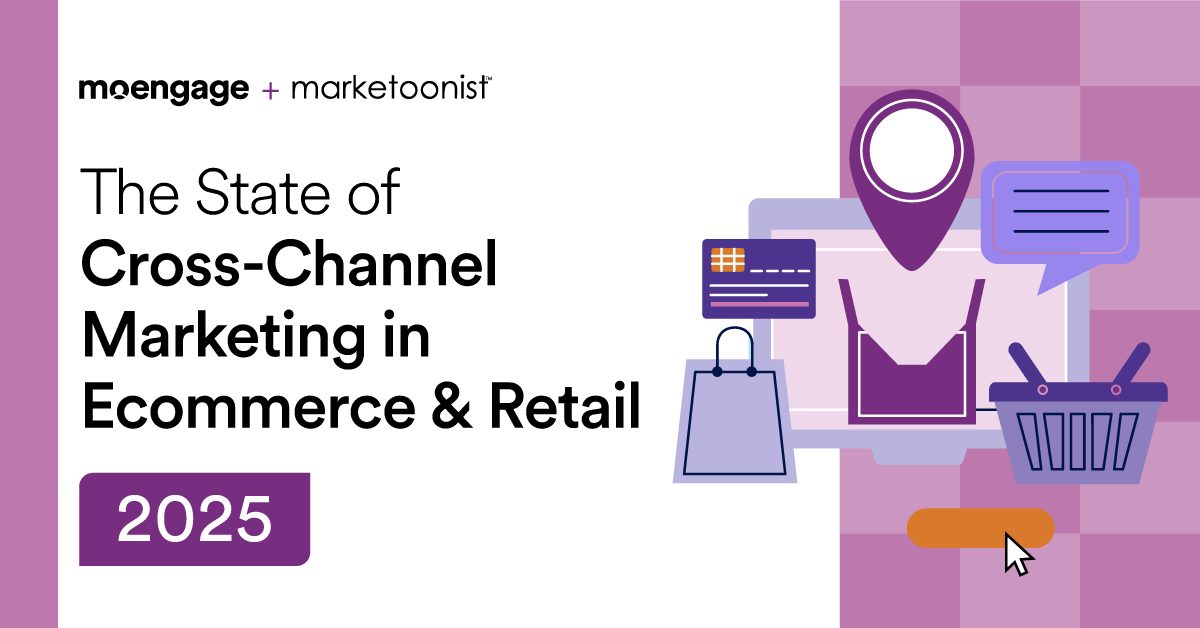
Reading Time: 9 minutes
The Retail and Ecommerce industry is currently facing numerous challenges, such as increasing competition, rising acquisition costs, and budget constraints.
But to help marketers like you stay on top of these changes, we’ve compiled an updated edition of The State of Cross-Channel Marketing in Ecommerce & Retail: 2025.
This year’s report:
- Analyzes findings from a survey of 226 Retail and Ecommerce professionals
- Uncovers how Retail marketing has evolved from 2024 and how it compares to the broader market in 2025
- Features cartoons from Tom Fishburne i.e. Marketoonist
Here are the top 5 findings from the report:
🛍️ Retail and Ecommerce marketers continue to put great emphasis on customer acquisition, with 48.7% citing finding new customers as their No. 1 priority.
🛍️ The top 5 engagement channels Retail marketers are using this year are Email (78.8%), Social Media (74.3%), Mobile Website (60.2%), Mobile App (51.3%), and Desktop Website (51.3%).
🛍️ Executing effective cross-channel communication was the #1 challenge this year (50.9%), with many more marketers struggling with it as compared to last year (38.3%). However, budget and resource constraints also closely followed as the 2nd biggest challenge this year (49.6%).
🛍️ Last year, 20.7% of marketers said they were not using AI as part of their cross-channel marketing strategy, but that number dropped significantly to 4.4% this year.
🛍️ 29.2% of Retail and Ecommerce marketers credit “integrated marketing technology” as the #1 factor for building effective cross-channel marketing strategies.
For more insights, download your copy of The State of Cross-Channel Marketing in Ecommerce & Retail: 2025. Alternatively, you can find highlights from last year’s report below.
State of Cross-Channel Marketing in Ecommerce & Retail: 2024
In today’s fast-paced digital landscape, Ecommerce & Retail cross-channel marketing has become crucial for engaging with customers effectively.
With an array of channels at their disposal, brands must navigate the ever-evolving marketing landscape to stay ahead of their competition, which is why we conducted a survey to understand the state of cross-channel marketing for B2C brands.
We found that Ecommerce and & Retail brands face a unique set of challenges including difficulty understanding and fully mapping the customer’s journey, which is critical to know what marketing channels are effective and how best to use personalization and segmentation strategies to communicate with customers.
Interestingly enough, the adoption of robust customer engagement technology is lagging with spreadsheets acting as the main program management tool, even though there is an appetite to invest more in customer retention and loyalty.
In this article, we will explore the specific responses from marketers in the Ecommerce & Retail space, uncovering the most popular engagement channels, the top barriers they encounter when executing cross-channel marketing, and some of the innovative solutions they can adopt to drive success.
Let’s get to it.
Who We Surveyed: Methodology and Demographics
Responses We Analyzed:
- All Responses: 730
- Ecommerce & Retail Responses: 222
Roles and Company Size
The majority of respondents said they are a Team Lead (32.9%) with 47.3% saying they are Director/Management or another C-Level executive. In terms of company size, 45.9% of respondents represent companies with more than 200 employees.
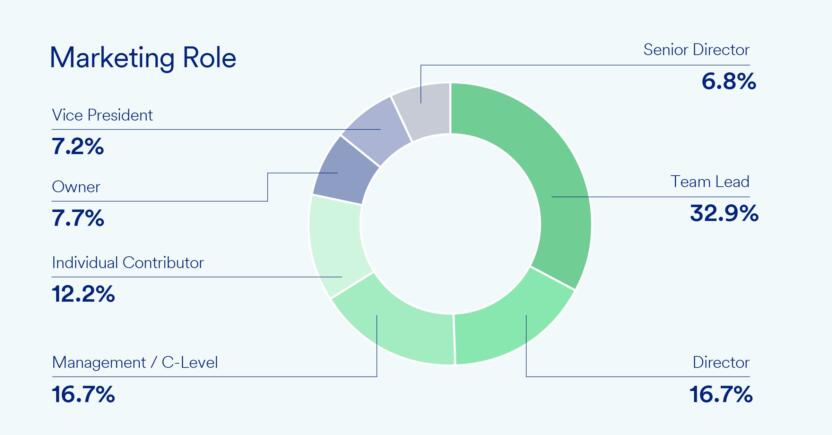
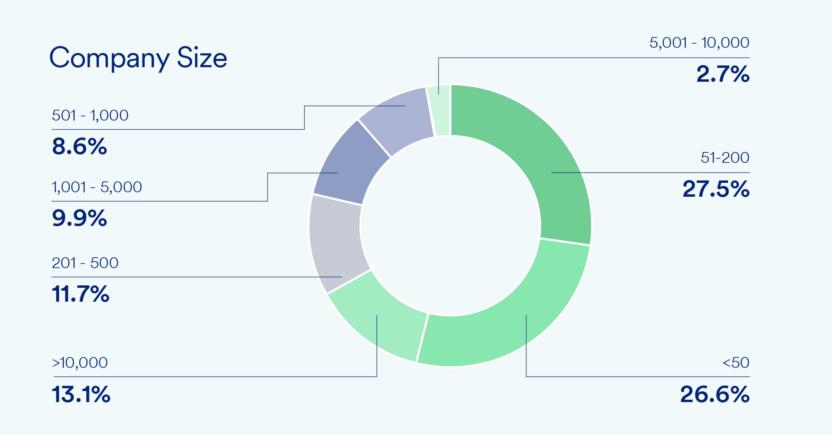
Channels
According to our broad set of survey results, the most popular engagement channels that B2C marketers use are:
- Email (89.6%),
- Social Media (80.3%),
- Desktop Website (67.1%),
- Mobile Website (65%).
- Mobile App (49)%
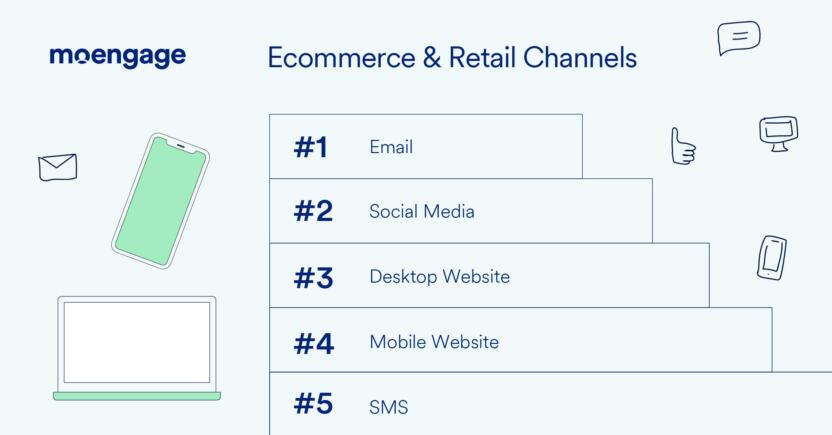
When looking specifically at the Ecommerce & Retail industry, we found that brands follow suit for the most popular channels they use until we get to the fifth spot. They’ve deviated by prioritizing SMS over Mobile App as a key part of their cross-channel marketing strategy.
There are a few reasons why this might be the case. Let me break it down for you:
First off, SMS lets brands communicate directly with their customers’ mobile devices because it is built in and doesn’t require a download. This is super handy for time-sensitive promos, flash sales, transactional messages, or any urgent updates from the brand.
Second, SMS messages have higher open and click-through rates compared to other channels like email. One study found that SMS campaigns have a 98% open rate and a 10.7% CTR. Customers are quick to open and read their text messages, so brands have a better chance of having their marketing messages seen and responded to.
Another fun fact: today’s customers are all about their mobile devices. They love shopping and interacting with brands on their phones. So, using SMS is a smart move to reach and connect with these mobile-centric customers.
Finally, SMS allows for personalized and targeted marketing. Brands can send customized offers, discounts, or product recommendations based on what their customers are into. It’s all about making the messages relevant and effective.
Oh, and here’s the cherry on top: customers have to opt-in to receive SMS marketing messages. That means the brand is reaching an audience that’s already interested and engaged.
The conversion rates and overall performance tend to be higher compared to channels where messages might be seen as intrusive, making SMS an ideal channel for brands in this industry.
Objectives
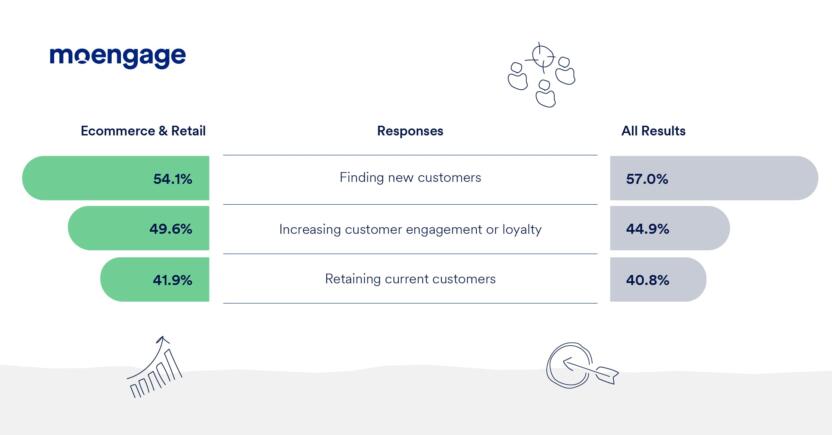
While it’s still important for Ecommerce & Retail brands to find new customers, they actually put more emphasis on engaging and keeping their current customers compared to the general population of respondents.
Brands in this industry operate in a super competitive market where customer loyalty can make a big difference in their profitability. They’ve realized that it’s often cheaper to keep existing customers happy than to constantly chase after new ones.
And here’s the cool part: existing customers are more likely to keep coming back for more and can even become brand advocates who spread the word about the brand to their friends.
AI Usage
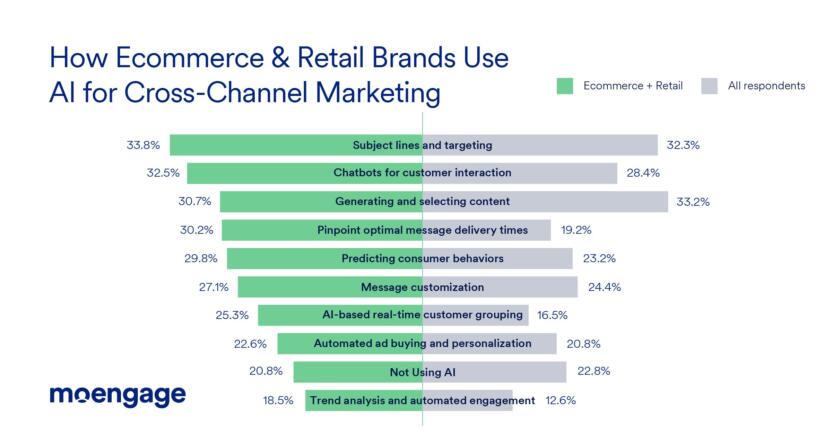
Based on the graph, you can see that, when it comes to AI in cross-channel marketing for Ecommerce & Retail, two key use cases stand out:
- “AI-enhanced subject lines and targeting” and
- “AI Chatbots for instant customer interaction”
But why might this be the case?
Well, successful Ecommerce & Retail brands have a ton of customers, and they need to make their marketing messages stand out. That’s where AI comes in.
By analyzing customer data and behavior, AI can generate subject lines that are super personalized and targeted to each individual. This means customers are more likely to open those emails and engage with the brand’s marketing campaigns.
Now, let’s talk about chatbots.
You know those little pop-ups on websites that offer instant help? That’s AI-powered chatbots in action. For Ecommerce & Retail brands, chatbots are a game-changer.
They can handle a bunch of customer interactions all at once, providing quick responses and even recommending products. This means brands can offer instant support and engage with customers 24/7, making the whole shopping experience smoother and more convenient.
Challenges
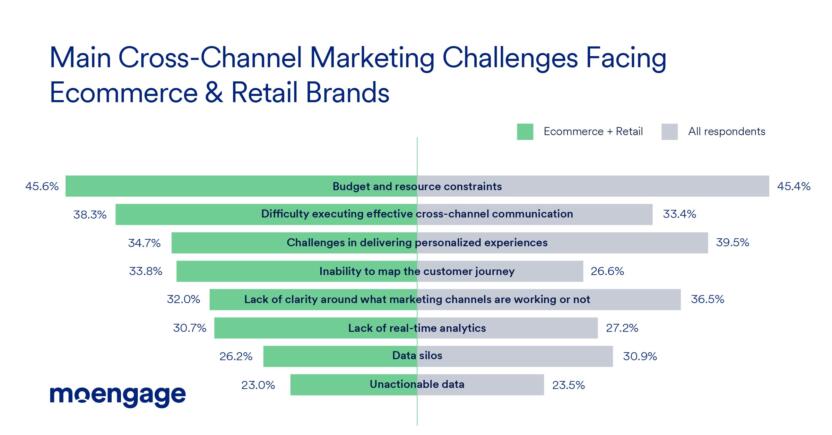
According to the survey data, both Ecommerce & Retail brands and the overall respondent group agree that their primary challenge is “budget and resource constraints.”
But here’s where things get interesting. When it comes to executing effective Ecommerce & Retail cross-channel marketing and communication, these businesses struggle more than the general group of respondents (33.4%).
Makes sense, considering all the different digital platforms they have to juggle with, to engage with their customers.
On the flip side, brands in this space appear to have a leg up when it comes to delivering personalized experiences. Only 34.7% of them find it challenging, while 39.5% of the general group have trouble with this.
Also, Ecommerce & Retail brands express greater concern about mapping the customer’s journey. About 33.8% of them see it as a key challenge, while only 26.6% of the total respondent group feels the same way.
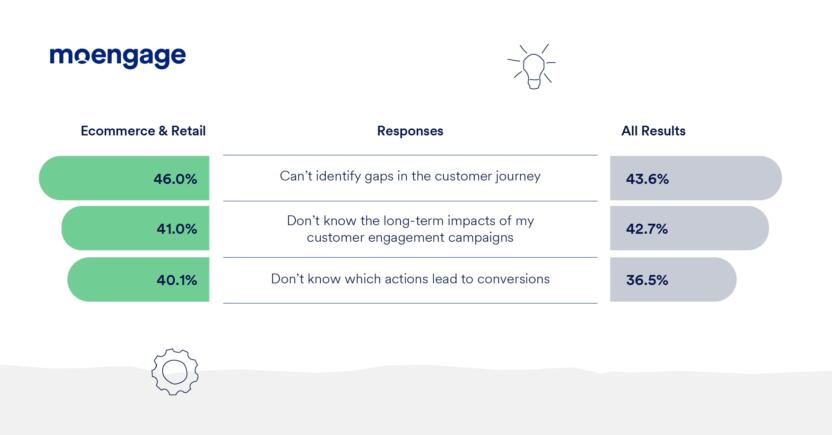
Along the same lines, Ecommerce & Retail brands have identified their biggest blind spot as identifying gaps in the customer’s journey, while the general respondents are more concerned about timely personalization (45.4%).
Unlike the retail experience of the past, today’s companies heavily rely on digital platforms. This means the customer’s journey can get pretty fragmented and complex. It’s like trying to connect the dots across multiple touchpoints.
And that’s where the challenge lies for these brands. It can be tough for them to trace a customer’s path and understand the long-term impacts of their marketing campaigns or figure out which actions actually lead to conversions. Having the proper technology can help reduce these challenges, which is what we’ll discuss in the next section.
Technology
From our survey we found that a higher percentage (21.6%) of B2C Ecommerce & Retail brands are using spreadsheets to manage their customer engagement programs than the general group of respondents (however, this was the number one response for both).
Unfortunately, relying on spreadsheets to manage customer engagement programs might be a mistake because spreadsheets have limitations in terms of scalability, collaboration, and automation.
As customer data grows, spreadsheets can become cumbersome and prone to errors. They lack real-time updates and can’t provide a holistic view of customer interactions.
Additionally, spreadsheets require manual data entry and lack the automation capabilities needed for efficient customer engagement.
Investing in a dedicated Customer Engagement Platform (CEP) can streamline processes, improve collaboration, and provide advanced analytics for better decision-making and personalized experiences.
Best Practices
When asked about what contributes the most to a successful cross-channel marketing strategy, “leveraging customer data analytics for targeted marketing decisions” was the top response.
Analyzing customer data gives them valuable insights into behaviors, preferences, and trends. Armed with this knowledge, they can create strategies that hit the mark and deliver personalized experiences that customers love, which keeps them coming back for more.
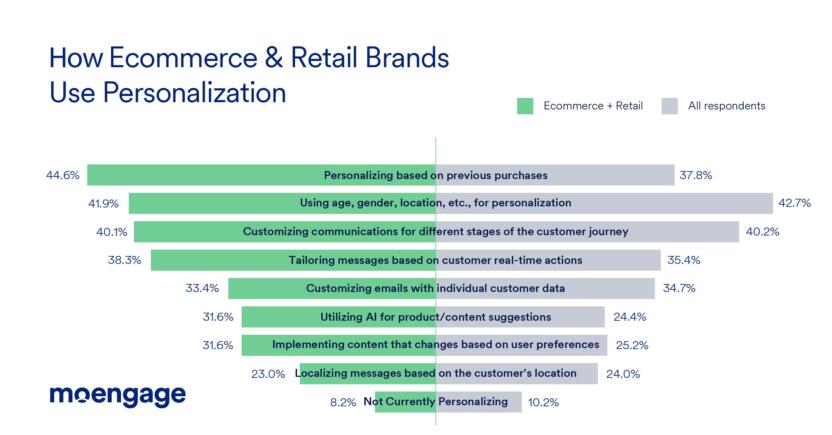
Based on the data, it is clear that Ecommerce & Retail brands have realized the significance of Ecommerce personalization in their customer communications, with 91.9% employing some form of personalization. What’s interesting is that a higher percentage of these brands are now using personalization techniques based on previous purchases, compared to the general group.
So, what does this mean? These brands are going the extra mile to tailor their marketing messages and content to each customer. They take into account their past buying behavior and preferences to create a more personalized and relevant experience. This approach pays off because it increases the chances of customer engagement and conversion.
But that’s not all.
Companies in this industry are also tapping into the power of artificial intelligence (AI) for product and content suggestions. They use smart algorithms that analyze heaps of customer data, like browsing history, purchase history, and demographic information. This allows them to generate personalized recommendations that align perfectly with each customer’s interests and preferences.
By leveraging AI for product and content suggestions, Ecommerce & Retail brands are taking customer experience to the next level. They provide relevant and tailored recommendations that make customers feel understood and valued. And you know what happens when customers feel that way? They engage more, and that ultimately leads to increased sales.
AI can be leveraged by marketers to figure out things like “best time to send” and “best channels” to use, and also to optimize journey flows. The fact that these brands are adopting personalization and AI shows their dedication to delivering a personalized and targeted experience.
Ecommerce & Retail Cross-Channel Marketing: Closing Thoughts
In the dynamic world of Ecommerce & Retail, brands that use AI, analyze customer data, and create personalized experiences are leading the way in innovation. To maintain a competitive edge in this industry, it is crucial to stay agile and adapt to emerging trends and technologies.
Using a Customer Engagement Platform (CEP) like MoEngage can provide you with the tools and insights you need to achieve your cross-channel marketing objectives.
MoEngage offers a range of solutions that can help Ecommerce & Retail companies improve their cross-channel communication. With 2.2 billion experiences delivered monthly across multiple channels, you can ensure that your message reaches your customers effectively.
Additionally, MoEngage enables you to deliver personalized experiences, leading to a 12% increase in retention with unique 1:1 experiences. By understanding your customers’ preferences and tailoring your communication accordingly, you can build stronger relationships and drive loyalty.
Finally, our platform helps Ecommerce & Retail brands demystify the customer journey by providing segmented campaigns and automated workflows.
Schedule a demo today to see how MoEngage can help your Ecommerce & Retail business thrive.









